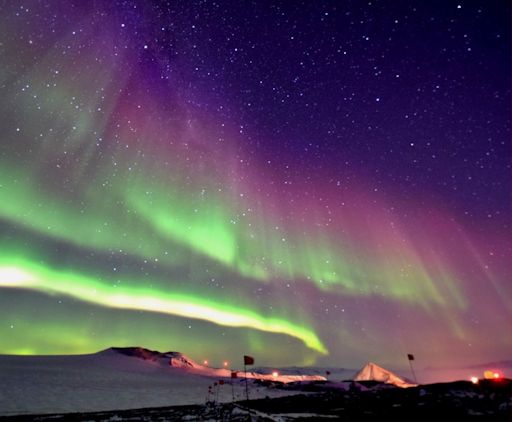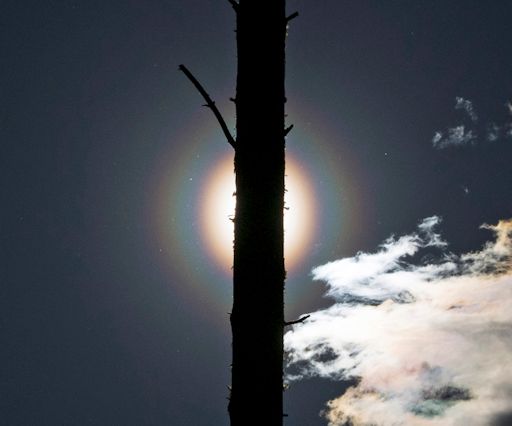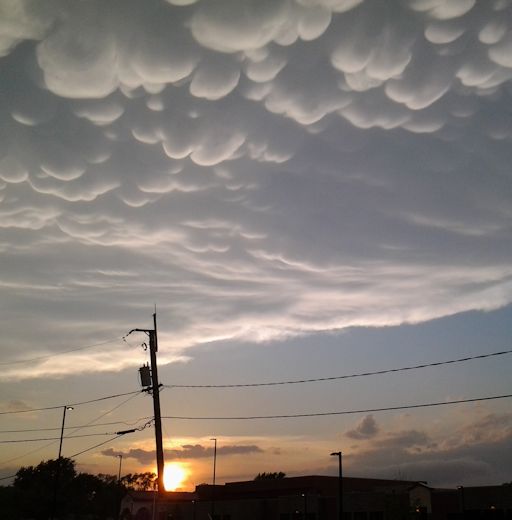Learn to photograph Northern Lights like a pro. Sign up for Peter Rosen's Aurora Photo Courses in Abisko National Park, winner of the TripAdvisor Certificate of Excellence Award 2015. | | |
QUIET SUN: Solar activity is low ... again. Continuing a trend that began in early May, the sun is mostly quiet with little chance of a significant flare on June 16th. NOAA forecasters put the odds of an X-class explosion at no more than 5%. Solar flare alerts: text, voice
ANTARCTIC AURORAS: With the approach of southern winter, night is falling across Antarctica. The night sky, however, is anything but dark. "On June 11th, the South Pole lit up with one of the best displays of auroras anyone has seen in years," reports Liz Widen, a science engineer wintering over at McMurdo Station. "The show lasted more an hour."

"They were extremely vivid and active," says Widen. "It was hard to keep taking photos, however, with a wind chill of -45 C."
More southern lights could be in the offing. NOAA forecasters estimate a 60% chance of polar geomagnetic storms on June 16th as Earth exits a high-speed solar wind stream. Aurora alerts: text, voice
Realtime Aurora Photo Gallery
POLLEN CORONAS: It begins with a sneeze. Pollen floating through the air tickles your nose, and your body responds by expelling the allergen. Gesundheit! When the paroxysm subsides, look up at the sky. The same pollen that makes you sneeze can also make beautiful coronas around the sun, like this one photographed on June 15th by Vesa Vauhkonen of Rautalampi, Finland :

"Pine is strongly flowering now in the middle Finland, and the coronas have been quite impressive over the past few days," says Vauhkonen. "But less impressive is the penetration of pollen everywhere--especially in the eyes and noses of people and animals. "
Atmospheric optics expert Les Cowley explains the phenonenon: "Coronas are produced when light waves scatter from the outsides of small particles. Tiny droplets of water in clouds make most coronas, but opaque equal-sized pollen grains do even better. They make small but very colorful multi-ringed coronas."
"Unlike water droplets, pollens are non-spherical--and this adds to their magic," he continues. "Many have air sacs to help carry them in the wind. These align the grains to give beautiful elliptical coronas with bright spots." This is why Vauhkonen's pollen corona looks the way it does.
As northern spring turns into summer, pollen coronas become increasingly common. Look for them the next time your nose feels a tickle.
MAMMATUS CLOUDS: On June 8th, during a gap between storms, a remarkable cloud formation appeared over Munster, Indiana. "I have never seen anything like it," says Cassandra Sotos, who photographed the apparition:

These are called "mammatus clouds." Named for their resemblance to a cow's underbelly, they sometimes appear at the end of severe thunderstorms when the thundercloud is breaking up. They are interesting in part because they're formed by sinking air. (Most clouds are formed by rising air.) Contrary to myth, however, they don't continue sinking downward to form tornadoes.
"The upside down convection was stunning," says Sotos.
Researchers have called mammatus clouds an "intriguing enigma," because their inner workings are not fully understood. The clouds are fairly common but often go unnoticed because potential observers have been chased indoors by the rain. If you are one of them, go back outside when the downpour stops; you could witness a beautiful mystery in the sky.
Realtime Space Weather Photo Gallery
Realtime NLC Photo Gallery
Realtime Aurora Photo Gallery
Realtime Sprite Photo Gallery
Every night, a network of NASA all-sky cameras scans the skies above the United States for meteoritic fireballs. Automated software maintained by NASA's Meteoroid Environment Office calculates their orbits, velocity, penetration depth in Earth's atmosphere and many other characteristics. Daily results are presented here on Spaceweather.com.
On Jun. 16, 2015, the network reported 14 fireballs.
(14 sporadics)

In this diagram of the inner solar system, all of the fireball orbits intersect at a single point--Earth. The orbits are color-coded by velocity, from slow (red) to fast (blue). [Larger image] [movies]
Potentially Hazardous Asteroids (
PHAs) are space rocks larger than approximately 100m that can come closer to Earth than 0.05 AU. None of the known PHAs is on a collision course with our planet, although astronomers are finding
new ones all the time.
On June 16, 2015 there were potentially hazardous asteroids.
Notes: LD means "Lunar Distance." 1 LD = 384,401 km, the distance between Earth and the Moon. 1 LD also equals 0.00256 AU. MAG is the visual magnitude of the asteroid on the date of closest approach. | | The official U.S. government space weather bureau |
| | The first place to look for information about sundogs, pillars, rainbows and related phenomena. |
| | Researchers call it a "Hubble for the sun." SDO is the most advanced solar observatory ever. |
| | 3D views of the sun from NASA's Solar and Terrestrial Relations Observatory |
| | Realtime and archival images of the Sun from SOHO. |
| | from the NOAA Space Environment Center |
| | the underlying science of space weather |
| | Web-based high school science course with free enrollment |

